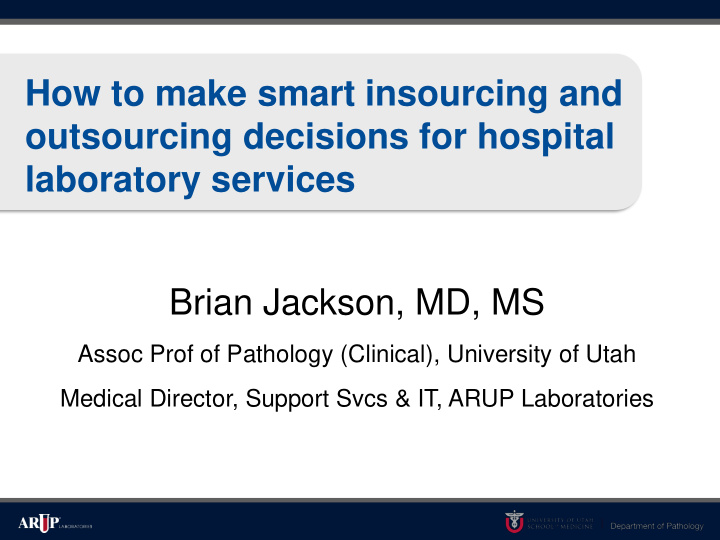



How to make smart insourcing and outsourcing decisions for hospital laboratory services Brian Jackson, MD, MS Assoc Prof of Pathology (Clinical), University of Utah Medical Director, Support Svcs & IT, ARUP Laboratories
Goal of Presentation • Equip lab professionals to work with health system administration to make smarter business decisions
Vertically Integrate vs. Outsource • Very common business question – Even more so outside of healthcare space – Manufacturing and service industries Reference: Michael J. Mol. Outsourcing: Design, Process and Performance . 2007: Cambridge Univ Press.
Vertically Integrate vs. Outsource Corporate Executive Electricity Generation Typically Typically integrated outsourced
Common Clinical Lab Scenarios • Service outsourcing: call center, website, LIMS, etc. • Test outsourcing: POC versus centralized lab versus reference lab • Test services for outreach community: Sell to reference lab • Lab management service agreements • Selling hospital lab to reference lab
Common Pitfalls in Outsourcing Decisionmaking
Reason #1: Treating it as a revenue problem • “Revenue is under threat so we should outsource” • Why would we think this way? – Fee-for-service healthcare business culture – Culture of “Revenue cycle management” – Side effect = less focus on costs and clinical operations
Reason #2: Treating it as a capital problem • “We need capital for X, so let’s sell the lab business” • Hospitals in a capital crunch lose negotiating leverage • Puts restraints on future operations – How many hospitals really only expect to be around for the next 5 years or so?
Reason #3: Misunderstanding “Core Competence” May/June 1990
Core Competence Theory • What it says: – Build strategy around those things your organization is uniquely good at. • What it does not say: – Only do the stuff you’re good at, and outsource the rest
• Decades-long core competence in clinical care processes • Tightly linked to clinical informatics • In-house developed EHR system (HELP) • Software dev not seen as core competence • Outsourced EHR to GE in the mid-2000s • Failed project with huge opportunity costs
Reason #4: Treating direct costs as if they were total costs • Direct costs for lab tests are easy to measure – Labor, reagents, instruments • Indirect costs are hard to measure – Pharmacy – Length of stay
Are lab tests a commodity?
Healthcare Value Equation Net Clinical Benefit Value = $ • Suppose a lab test can be run by two different laboratories. • Will clinical benefit be identical?
What should be considered when deciding to vertically integrate vs. outsource?
Vertically Integrate vs. Outsource: Key Considerations • Direct costs • Coordination • Customization • Organizational learning and improvement • Cost of (poor) quality
Coordination • Most clothing manufacturing is outsourced to lowest cost source • Zara manufactures close to home – “Fast Fashion” – Rapid design cycles – Stay on cutting edge of fashion
Coordination Questions for Clinical Labs • How well do you fine-tune lab operations in sync with clinical operations? • How realistically could an outside lab company replicate that level of coordination?
Customization VS
Automotive Supply Chains ca. 1980 • American auto manufacturers – Competitive bidding for components (brakes, steering, etc.) – Limited information sharing – Lower per-unit costs – Higher engineering costs • Toyota – Two preferred suppliers for every category of part – Co-located engineers – Higher per-unit costs – Lower design and engineering costs
Customization Questions for Clinical Labs • Where different clinical departments have different dx testing needs, can you appropriately customize your services to meet those needs? • How realistically could an outside lab company replicate that level of customization?
Learning and Improvement
Dell Computer Sourcing circa 1990s • Focused on assembly and distribution, not part manufacturing • Sourced circuit boards from Taiwan • Suppliers provided more and more pre-assembled parts • Dell lost expertise in assembly; became replaceable
Customization Questions for Clinical Labs • How does the lab contribute to the overall health system’s clinical learning and improvement? • How realistically could an outside lab company play this function?
Cost of (Poor) Quality British Railways
British Railways: Outsourced Maintenance Successful maintenance Growing safety issues Maintenance outsourcing insourced 1990 2002 2003
British Rail: What Happened? • Prior to early 1990s, British Rail was mostly vertically integrated – Maintenance could be safely outsourced because verification was in- house • Early 1990s, infrastructure was broken off into separate company – Railtrack didn’t have its own measurement equipment – No independent verification of repairs – Couldn’t negotiate good contracts (and costs actually increased) • 2003 insourcing of maintenance = higher safety, lower costs
British Rail: Summary • Outsourcing is not inherently: – Cost-saving – Quality-reducing • It comes down to capabilities and relationships – If outsource provider is more capable – If parent company can manage relationship and ensure quality
Quality Questions for Clinical Labs • Are you measuring quality from a health system perspective, not just a lab perspective? • How realistically could an outside lab company provide that same level of system-level quality?
Take-Home Messages for Clinical Labs • Outsourcing versus vertical integration is a core strategic decision • Because clinical care is a core competence of healthcare orgs, – Clinical lab services have to be tightly integrated into the health system
Take-Home Messages for Clinical Labs • Correct financial lens: (Total) costs and operational performance – Long-term strategy, not short-term financial engineering – Not a revenue problem – Not a capital problem
Take-Home Messages for Clinical Labs • Clinical impact is usually a bigger cost driver than testing costs – Every clinical unit has different workflow needs for lab testing – Coordination, customization are all key.
Take-Home Messages for Clinical Labs • Don’t neglect cost of poor quality – Clinical perspective, not just lab perspective – Major quality failures may be infrequent, but incredibly costly – “Minor” quality failures are also costly, but often invisible
Any Questions? • Feel free to contact me after the presentation: – brian.jackson@aruplab.com – @BrianJClinPath
Recommend
More recommend